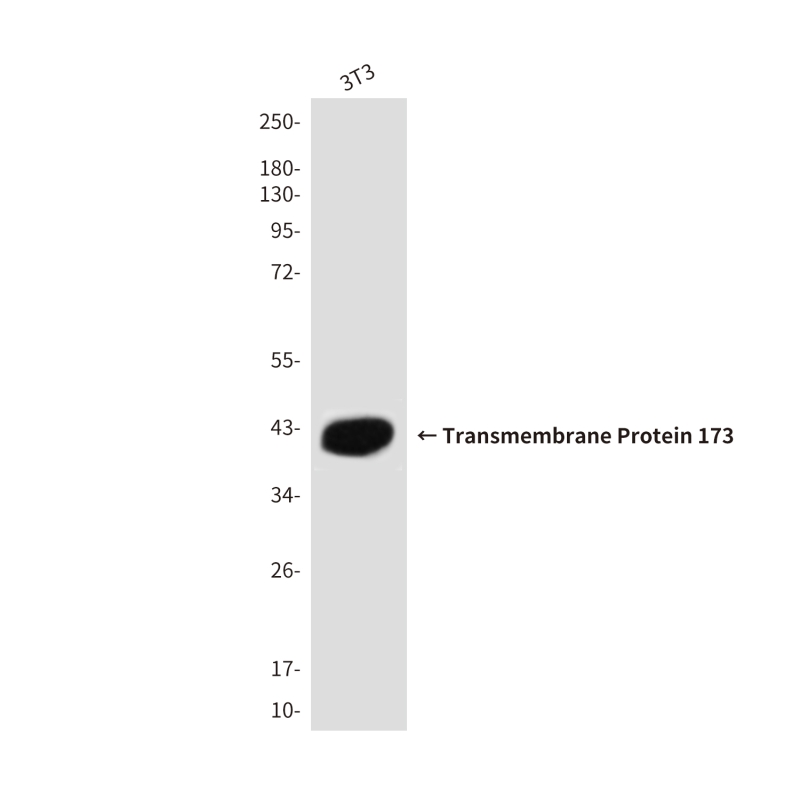
| WB | 咨询技术 | Human,Mouse,Rat |
| IF | 咨询技术 | Human,Mouse,Rat |
| IHC | 咨询技术 | Human,Mouse,Rat |
| ICC | 技术咨询 | Human,Mouse,Rat |
| FCM | 咨询技术 | Human,Mouse,Rat |
| Elisa | 咨询技术 | Human,Mouse,Rat |
| Aliases | ERIS; MITA; MPYS; SAVI; NET23; STING; hMITA; hSTING; STING-beta;Transmembrane Protein 173 |
| Entrez GeneID | 340061 |
| WB Predicted band size | Calculated MW: 42 kDa; Observed MW: 42 kDa |
| Host/Isotype | Rabbit IgG |
| Antibody Type | Primary antibody |
| Storage | Store at 4°C short term. Aliquot and store at -20°C long term. Avoid freeze/thaw cycles. |
| Species Reactivity | Human,Mouse |
| Immunogen | Purified recombinant Human STING protein fragments expressed in E.coli |
| Formulation | Purified antibody in PBS with 0.05% sodium azide,0.5%BSA and 50% glycerol. |
+ +
以下是关于STING抗体的参考文献示例(注:以下内容为示例性描述,实际文献请通过学术数据库查询):
---
1. **文献名称**:*"A STING-targeting antibody suppresses lethal inflammatory responses in murine models"*
**作者**:Liu, Y. et al.
**摘要**:本研究开发了一种靶向STING蛋白的中和性单克隆抗体,通过阻断其下游信号通路,显著减轻了小鼠模型中由cGAS-STING过度激活引发的致死性炎症反应,为自身免疫疾病治疗提供了新策略。
2. **文献名称**:*"High-affinity anti-STING antibodies for spatial mapping of immune activation in tumors"*
**作者**:Garcia-Beltran, W. et al.
**摘要**:利用高特异性STING抗体,通过免疫组化技术揭示了肿瘤微环境中STING蛋白的分布与活性状态,发现其与T细胞浸润程度相关,为癌症免疫治疗评估提供了生物标志物。
3. **文献名称**:*"Antibody-mediated STING degradation enhances checkpoint inhibitor efficacy in pancreatic cancer"*
**作者**:Zhang, L. et al.
**摘要**:报道了一种抗体- PROTAC偶联物,可靶向降解肿瘤细胞中的STING蛋白,逆转免疫抑制微环境,显著提高PD-1抑制剂在胰腺癌模型中的疗效。
4. **文献名称**:*"Structural basis of STING recognition by a virus-derived antibody fragment"*
**作者**:Kim, H. et al.
**摘要**:通过冷冻电镜解析了病毒来源的单域抗体与STING蛋白的结合表位,阐明了其抑制干扰素信号的结构机制,为设计新型STING拮抗剂奠定基础。
---
建议通过PubMed、Web of Science或Google Scholar搜索关键词“STING antibody”、“STING neutralizing antibody”或“cGAS-STING signaling”获取最新文献。知名期刊如*Nature Immunology*、*Cell*和*Science Immunology*常发表相关研究。
The STING (Stimulator of Interferon Genes) protein, discovered in 2008. is a central component of the innate immune system. It acts as a cytosolic DNA sensor, detecting mislocalized DNA from pathogens (e.g., viruses) or damaged host cells. Upon activation by cyclic dinucleotides (e.g., cGAMP), STING triggers signaling cascades that induce type I interferons and proinflammatory cytokines, bridging innate and adaptive immunity. Dysregulated STING signaling is linked to autoimmune diseases (e.g., SLE), neurodegenerative disorders, and cancer.
STING-targeting antibodies have emerged as therapeutic tools. Agonistic antibodies aim to boost antitumor immunity by activating STING in cancer cells or antigen-presenting cells, enhancing T-cell responses. Conversely, antagonistic antibodies suppress hyperactive STING signaling in autoimmune conditions. Challenges include balancing systemic immune activation with toxicity (e.g., cytokine storms) and improving tissue-specific delivery. Recent advances in structural biology and antibody engineering have enabled the development of conformation-specific antibodies that precisely modulate STING’s activation states. Several candidates are in preclinical or early clinical trials, reflecting their potential in immunotherapy and precision medicine. Ongoing research focuses on optimizing pharmacokinetics and combination strategies with checkpoint inhibitors or vaccines.
×